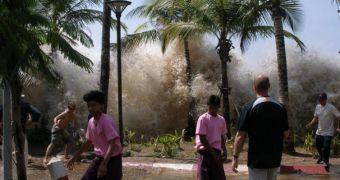Newcastle University experts have only recently devised a groundbreaking mathematical model that could potentially be used to assess the risk of a tsunami occurring, to determine which area is most likely to get hit and in what time frame the destructive wave will reach the coast. It goes without saying that such a model would go along the way towards reducing the number of casualties in the event of another massive tsunami, such as the one that covered stretches of Thailand a few years back.
The 2004, the Boxing Day tsunami disaster was one of the worst in recorded history, affecting a large number of coastal communities in countries such as Thailand, India, Sri Lanka and Indonesia. The event was triggered by a massive underwater earthquake, which displaced large amounts of water that began traveling at very high speeds in all directions. In the end, six waves were produced and they battered each of the shores they reached with enormous power, killing people, animals and leveling buildings, homes and businesses.
This event was the thing that made NU professor Robin Johnson want to do something about it. And since no one is able to stop the earthquakes from happening, the scientist has settled on doing the next best thing, namely on devising a way of letting authorities know where another tsunami will hit and when. Also, he wants his model to also supply an approximative time frame, so that state officials could make the most informed decision possible under the circumstances, and make it fast.
“What we found was that the number and height of the tsunami waves hitting the shoreline depends critically on the shape of the initial surface wave in deep water. From this, it is possible to work out whether a 'trough' or a 'peak' is the leading wave. In the case of a trough then the familiar sight of the tide suddenly going out is the precursor to an approaching tsunami. If a peak is the leading wave, there is no warning except a fast-approaching wall of water. Potentially, this could provide vital information for areas facing an impending disaster,” Johnson, who teaches Applied Mathematics at NU, says.
The paper detailing the finds and the model designed by Johnson and colleague Adrian Constantin, from the University of Vienna, in Austria, are published in a recent edition of the academic journal Science Direct: Fluid Dynamics Research, and has already been chosen as the publication's “best paper of the year.”

 14 DAY TRIAL //
14 DAY TRIAL //